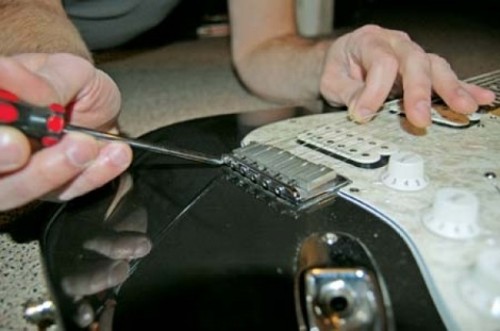As in a real, honest-to-Jimi electric guitar—not a Guitar Hero controller, kiddies. Setting the intonation on an electric guitar (making it play in tune at every point along the neck) is a simple operation that, in most cases, doesn’t require a trip to the guitar shop. Unless you really want to spend $30 to $50 and hang out at Guitar Center and dissect Alan Holdsworth’s reverse hammer-on legato technique on Jean-Luc Ponty’s Enigmatic Ocean or the banality of Joe Satriani’s work with Chickenfoot. If so, you have larger problems to address.
Your guitar’s intonation may be off due to string height (too high off the neck, or too low) or a change in string gauge (thickness; real players use .10-.46 and up, anything skinnier is for pussies and Eddie Van Halen). Which is why, prior to setting the intonation, it’s important to settle on a height and gauge—and then buy some new damned strings. Attempting to intonate an axe with old, dead strings is as pointless and impossible as differentiating the guitarists in Slayer. Can’t be done.
Once you’ve restrung the guitar, set the string height to either the manufacturer’s specifications (usually a pain in the ass to find) or by feel to your comfort (much easier—just don’t go too low, Eddie). The guitar’s bridge will tend to be either a Gibson-style Tune-o-matic (one piece, with string saddles embedded) or Fender-style (individually adjustable saddles—takes longer, but more accurate). Tune the guitar, adjust the string height(s), retune, adjust more if needed, repeat until the height is where you want it at properly-tuned string tension.
If you’re getting major fret buzz anywhere along the neck, you’ve gone too low and/or require a truss rod (the metal bar inside the guitar neck that keeps it straight, as well as from snapping due to string tension) adjustment. Since truss rod adjustments are an exacting/potentially-damaging procedure best left to pros, for the purposes of abbreviated hack Gift Guide filler, I’m going to say just jack those strings up off the neck a little more (note to publisher: lawsuit avoided).
Plug the guitar into an electronic tuner, tune to standard EADGBE (or whichever tuning you use most). Once tuned to pitch, hit a harmonic at the 12th fret (lightly touching the string directly over the fret to produce a bell-like chime) of the low E string. If the tone registers sharp, move the bridge saddle back, away from the neck. If flat, move saddle forward toward the neck. Then, once set, fret the note on the 12th fret and repeat the previous procedure. Do this with each string until the open, harmonic and fretted notes register as in-tune for all six.
If you’re playing a seven-string guitar, please pull up your pants and return to your Korn tribute band.
This technique can also apply to an electric bass guitar, but not necessarily an acoustic guitar, which almost universally have fixed bridges that don’t allow for movement or exact intonation. But really, since playing unplugged won’t attract worship or groupies (Fact: There’s no Acoustic Guitar Hero video game), why bother?
Speaking of...
-
Pygmalion Theatre Company: Seven
- Feb 23, 2012
-
Somewhere
Pity Party: Why should we care about Somewhere's existential despair?
- Feb 4, 2011
-
July 23-29: Are you ready to experience something resembling time-travel?
Storm chasers are people who love traveling around the continent in pursuit of wild weather. Nothing feeds their lust for life more than getting up-close and personal with a tornado or supercell thunderstorm.
- Jul 22, 2009
- More »
More by Bill Frost
-
True TV April 2024: Hidden gems on Tubi
Seven series worth a stream on the free-but-doesn't-suck service
- Apr 3, 2024
-
Flashback 2020: Lockdown TV
The shows we were all watching when we were stuck at home.
- Mar 6, 2024
-
Fox News is bad, but Utah's syndicated talk radio is even worse.
Radio Blah Blah
- Mar 6, 2024
- More »




